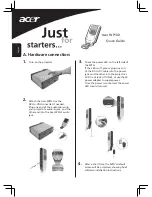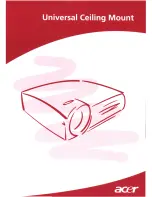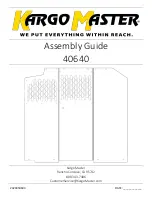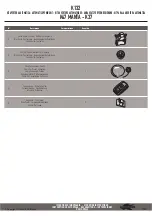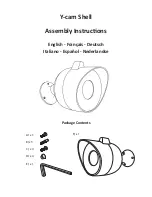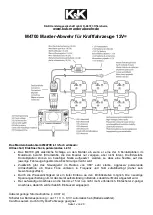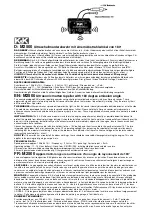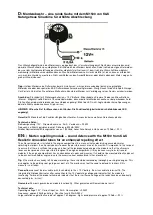
Consumer Safety Information
Riding a bike is dangerous. Not properly maintaining or inspecting your bike is even more dangerous. It’s
also dangerous not to read these instructions.
1.
Before riding the bicycle, be sure the brakes are properly installed and adjusted. If the brakes don’t
work properly, the rider could suffer serious and/or fatal injuries.
2.
Use this fork with cantilever-type brakes mounted to the existing mounting posts. Forks with hangerless
style braces were only designed for ‘V’- style or hydraulic cantilever brakes. Do not use any cantilever
brake other than those intended by the brake manufacturer to work with a hangerless brace. Do not
route the front brake cable and/or cable housing through the stem or any other mounts or cable stops.
Do not use a front brake cable leverage device mounted to the brace. Do not use disc-style brakes
mounted to the outer lower tube. The lower tubes were not designed to sustain the stresses such brakes
could place on them, and structural failure to the fork may result if any devices or types of brakes other
than a cantilever are mounted on the fork. Structural failure could result in loss of control of the
bicycle with possible serious and/or fatal injuries.
3.
Use extreme caution not to tilt the bicycle to either side when mounting the bicycle to a carrier by the
fork drop-outs (front wheel removed). The fork legs may suffer structural damage if the bicycle is tilted
while the drop-outs are in the carrier. Make sure the front fork is fastened down with a quick release.
Make sure the rear wheel is fastened down when using ANY bike carrier that secures the fork’s drop-
outs. Not securing the rear can allow the bike’s mass to side-load the drop-outs, causing them to break
or crack. If the bicycle tilts or falls out of its carrier, do not ride the bicycle until the fork is properly
examined for possible damage. Return the fork to your dealer for inspection or call RockShox if there is
any question of possible damage (See International Distributors listed by country on Page 17). A fork
leg or drop-out failure could result in loss of control of the bicycle with possible serious and/or fatal
injuries.
4.
If the fork ever loses oil or if it makes sounds of excessive topping out, stop riding the bicycle
immediately and have the fork inspected by a dealer or call RockShox. Continuing to ride with the fork
in either of these conditions could result in loss of control of the bicycle with possible serious and/or
fatal injuries.
5.
Always use genuine RockShox parts. Use of after-market replacement parts voids the warranty and
could cause structural failure to the fork. Structural failure could result in loss of control of the bicycle
with possible serious and/or fatal injuries.
I
MPORTANT
: R
OCK
S
HOX FORKS ARE DESIGNED FOR COMPETITIVE OFF
-
ROAD RIDING AND DO NOT COME WITH
THE PROPER REFLECTORS FOR ON
-
ROAD USE
. Y
OUR DEALER SHOULD INSTALL PROPER REFLECTORS TO MEET
THE
C
ONSUMER
P
RODUCT
S
AFETY
C
OMMISSION
’
S
(CPSC) R
EQUIREMENTS FOR
B
ICYCLE
S
TANDARDS IF THE
FORK IS GOING TO BE USED ON PUBLIC ROADS AT ANY TIME
.
Installation Instructions
It is extremely important that your RockShox Jett XC fork is installed correctly by a qualified technician with
proper tools. Improperly installed forks are extremely dangerous and can result in severe and/or fatal injuries.
1.
Remove the existing fork and lower headset race from the bicycle. Measure the length of the fork
steerer tube diameter against the length of the RockShox steerer. The RockShox steerer tube may need
cutting to the proper length. On threadless steerers (Aheadset design), make sure there is sufficient
length to properly clamp the stem (refer to stem manufacturer’s instructions). Remember to measure
twice and cut once.
I
MPORTANT
: D
O NOT ADD THREADS TO
R
OCK
S
HOX STEERERS
. T
HE STEERER TUBE CROWN ASSEMBLY IS A
ONE
-
TIME PRESS FIT
. R
EPLACEMENT OF THE ASSEMBLY MUST BE DONE TO CHANGE LENGTH
,
DIAMETER
,
OR
HEADSET TYPE
(
THREADED OR THREADLESS
). DO NOT
REMOVE OR REPLACE THE STEERER TUBE
,
THIS COULD
RESULT IN LOSS OF CONTROL OF THE BICYCLE WITH POSSIBLE SERIOUS AND
/
OR FATAL INJURIES
.
2.
Install the headset race (26.4 mm for 1" steerers, 29.9mm for 1-1/8" steerers) firmly against the top of
the fork crown. Install the fork assembly on the bike. Make sure there are sufficient threads to properly
lock the headset in place. On threadless steerers (Aheadset design), make sure there is sufficient length
to properly clamp the stem (refer to stem manufacturer’s instructions). Adjust the headset so you feel
no play or drag.
3.
Install the brakes according to the manufacturer’s instructions and adjust brake pads properly. Use the
fork only with cantilever-type brakes mounted to the existing mounting posts or disc style brakes
mounted to the tabs provided.
4.
On threaded steerers, insert stem to a minimum depth according to CPSC and JIS
standards. The stem must be inserted to a minimum engaging length not less
than 2.5 times the stem diameter from the lowest end of the stem, not the wedge
(see Fig. 1).
5.
Fit a brake cable to the RockShox fork brace mount. Forks with hangerless style
braces were designed for V-type, hydraulic cantilever brakes or disc style brakes
mounted to the tabs provided. Do not use any cantilever brake other than those
intended by the brake manufacturer to work with a hangerless brace. Do not
route the cable through the stem or any other mounts or cable stops! The cable should make a direct
route from the brake lever to the RockShox fork brace mount and be able to freely move up and down
with the suspension movement. It may be necessary to install a whole new cable.
N
OTE
: T
HE DISTANCE FROM THE TOP OF THE BRAKE CABLE HANGER TO THE BOTTOM OF THE BRACE CABLE
HOUSING STOP MUST BE A MINIMUM OF
12
MM WITH THE BRAKES APPLIED
. A
N IMPROPERLY INSTALLED FRONT
BRAKE CABLE COULD RESULT IN LOSS OF CONTROL OF THE BICYCLE WITH POSSIBLE SERIOUS AND
/
OR FATAL
INJURIES
.
6.
Adjust the front wheel quick release to clear the dropout’s counter bore. The quick release nut must be
tightened after the wheel is properly seated into the dropouts counter bore. Make sure four or more
threads are engaged in the quick release nut when it is closed. Orient the quick release lever in front of
and parallel to the lower tube in the locked position.
7.
Keep in mind tire clearance as you choose tires. Maximum tire size is 2.2" wide or 335mm radius. Be
sure to check this radius whenever you change tires. To do this, remove the spring stack (per instructions
on following pages), and compress fork completely to make sure at least 5 mm of clearance exists between
the top of the tire and the bottom of the crown. Exceeding this maximum will cause the tire to jam
against the crown when the forks are fully compressed. The upper tubes must always be fully engaged in
PN 950-001827-00, R
EV
A
P
AGE
7
P
AGE
6
PN 950-001827-00, R
EV
A
Fig.1
Содержание Jett XC 1999
Страница 1: ...1999 Jett XC Owner s Manual ...
Страница 39: ...PAGE 76 PN 950 001827 00 REV A ...




















